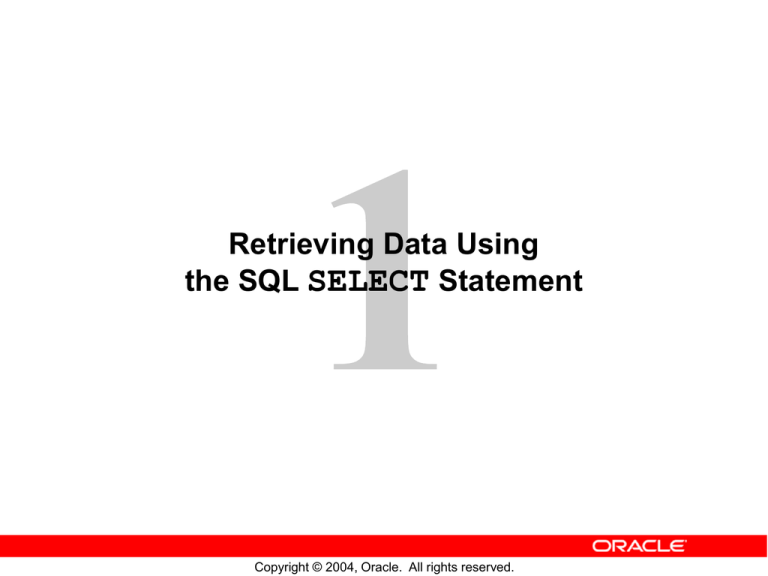
Retrieving Data Using
the SQL SELECT Statement
Copyright © 2004, Oracle. All rights reserved.
Objectives
After completing this lesson, you should be able to do
the following:
• List the capabilities of SQL SELECT statements
• Execute a basic SELECT statement
•
1-2
Differentiate between SQL statements and
iSQL*Plus commands
Copyright © 2004, Oracle. All rights reserved.
Capabilities of SQL SELECT Statements
Projection
Selection
Table 1
Table 1
Join
Table 1
1-3
Table 2
Copyright © 2004, Oracle. All rights reserved.
Basic SELECT Statement
SELECT *|{[DISTINCT] column|expression [alias],...}
FROM
table;
•
•
1-4
SELECT identifies the columns to be displayed
FROM identifies the table containing those columns
Copyright © 2004, Oracle. All rights reserved.
Selecting All Columns
SELECT *
FROM
departments;
1-5
Copyright © 2004, Oracle. All rights reserved.
Selecting Specific Columns
SELECT department_id, location_id
FROM
departments;
1-6
Copyright © 2004, Oracle. All rights reserved.
Writing SQL Statements
•
•
•
•
•
•
•
1-7
SQL statements are not case-sensitive.
SQL statements can be on one or more lines.
Keywords cannot be abbreviated or split
across lines.
Clauses are usually placed on separate lines.
Indents are used to enhance readability.
In iSQL*Plus, SQL statements can optionally be
terminated by a semicolon (;). Semicolons are
required if you execute multiple SQL statements.
In SQL*plus, you are required to end each SQL
statement with a semicolon (;).
Copyright © 2004, Oracle. All rights reserved.
Column Heading Defaults
•
iSQL*Plus:
– Default heading alignment: Center
– Default heading display: Uppercase
•
SQL*Plus:
– Character and Date column headings are leftaligned
– Number column headings are right-aligned
– Default heading display: Uppercase
1-8
Copyright © 2004, Oracle. All rights reserved.
Arithmetic Expressions
Create expressions with number and date data by
using arithmetic operators.
Operator
+
Add
-
Subtract
*
Multiply
/
1-9
Description
Divide
Copyright © 2004, Oracle. All rights reserved.
Using Arithmetic Operators
SELECT last_name, salary, salary + 300
FROM
employees;
…
1-10
Copyright © 2004, Oracle. All rights reserved.
Operator Precedence
SELECT last_name, salary, 12*salary+100
FROM
employees;
1
…
SELECT last_name, salary, 12*(salary+100)
FROM
employees;
…
1-11
Copyright © 2004, Oracle. All rights reserved.
2
Defining a Null Value
•
A null is a value that is unavailable, unassigned,
unknown, or inapplicable.
A null is not the same as a zero or a blank space.
•
SELECT last_name, job_id, salary, commission_pct
FROM
employees;
…
…
1-12
Copyright © 2004, Oracle. All rights reserved.
Null Values
in Arithmetic Expressions
Arithmetic expressions containing a null value
evaluate to null.
SELECT last_name, 12*salary*commission_pct
FROM
employees;
…
…
1-13
Copyright © 2004, Oracle. All rights reserved.
Defining a Column Alias
A column alias:
• Renames a column heading
• Is useful with calculations
• Immediately follows the column name (There can
also be the optional AS keyword between the
column name and alias.)
• Requires double quotation marks if it contains
spaces or special characters or if it is casesensitive
1-14
Copyright © 2004, Oracle. All rights reserved.
Using Column Aliases
SELECT last_name AS name, commission_pct comm
FROM
employees;
…
SELECT last_name "Name" , salary*12 "Annual Salary"
FROM
employees;
…
1-15
Copyright © 2004, Oracle. All rights reserved.
Concatenation Operator
A concatenation operator:
• Links columns or character strings to other
columns
• Is represented by two vertical bars (||)
• Creates a resultant column that is a character
expression
SELECT
FROM
last_name||job_id AS "Employees"
employees;
…
1-16
Copyright © 2004, Oracle. All rights reserved.
Literal Character Strings
•
A literal is a character, a number, or a date that is
included in the SELECT statement.
•
Date and character literal values must be enclosed
by single quotation marks.
Each character string is output once for each
row returned.
•
1-17
Copyright © 2004, Oracle. All rights reserved.
Using Literal Character Strings
SELECT last_name ||' is a '||job_id
AS "Employee Details"
FROM
employees;
…
1-18
Copyright © 2004, Oracle. All rights reserved.
Alternative Quote (q) Operator
•
•
•
Specify your own quotation mark delimiter
Choose any delimiter
Increase readability and usability
SELECT department_name ||
q'[, it's assigned Manager Id: ]'
|| manager_id
AS "Department and Manager"
FROM departments;
…
1-19
Copyright © 2004, Oracle. All rights reserved.
Duplicate Rows
The default display of queries is all rows, including
duplicate rows.
SELECT department_id
FROM
employees;
1
…
SELECT DISTINCT department_id
FROM
employees;
…
1-20
Copyright © 2004, Oracle. All rights reserved.
2
SQL and iSQL*Plus Interaction
SQL statements
Internet
browser
iSQL*Plus
commands
Query results
Formatted report
Client
1-21
Copyright © 2004, Oracle. All rights reserved.
Oracle
server
SQL Statements Versus
iSQL*Plus Commands
SQL
• A language
• ANSI standard
• Keyword cannot be
abbreviated.
• Statements manipulate
data and table definitions
in the database.
SQL
statements
1-22
iSQL*Plus
• An environment
• Oracle-proprietary
• Keywords can be
abbreviated.
• Commands do not allow
manipulation of values in
the database.
• Runs on a browser
• Centrally loaded; does not
have to be implemented
on each machine
iSQL*Plus
commands
Copyright © 2004, Oracle. All rights reserved.
Overview of iSQL*Plus
After you log in to iSQL*Plus, you can:
• Describe table structures
• Enter, execute, and edit SQL statements
• Save or append SQL statements to files
• Execute or edit statements that are stored in
saved script files
1-23
Copyright © 2004, Oracle. All rights reserved.
Logging In to iSQL*Plus
From your browser environment:
1-24
Copyright © 2004, Oracle. All rights reserved.
iSQL*Plus Environment
8
7
1
2
1-25
3
4
5
Copyright © 2004, Oracle. All rights reserved.
9
Displaying Table Structure
Use the iSQL*Plus DESCRIBE command to display the
structure of a table:
DESC[RIBE] tablename
1-26
Copyright © 2004, Oracle. All rights reserved.
Displaying Table Structure
DESCRIBE employees
1-27
Copyright © 2004, Oracle. All rights reserved.
Interacting with Script Files
SELECT last_name, hire_date, salary
FROM
employees;
2
1-28
Copyright © 2004, Oracle. All rights reserved.
1
Interacting with Script Files
1-29
Copyright © 2004, Oracle. All rights reserved.
Interacting with Script Files
1
1-30
Copyright © 2004, Oracle. All rights reserved.
Interacting with Script Files
D:\TEMP\emp_data.sql
3
1-31
Copyright © 2004, Oracle. All rights reserved.
iSQL*Plus History Page
3
2
1
1-32
Copyright © 2004, Oracle. All rights reserved.
iSQL*Plus History Page
3
4
1-33
Copyright © 2004, Oracle. All rights reserved.
Setting iSQL*Plus Preferences
1
2
3
1-34
Copyright © 2004, Oracle. All rights reserved.
Setting the Output Location Preference
2
1
1-35
Copyright © 2004, Oracle. All rights reserved.
Summary
In this lesson, you should have learned how to:
• Write a SELECT statement that:
– Returns all rows and columns from a table
– Returns specified columns from a table
– Uses column aliases to display more descriptive
column headings
•
Use the iSQL*Plus environment to write, save, and
execute SQL statements and iSQL*Plus
commands
SELECT *|{[DISTINCT] column|expression [alias],...}
FROM table;
1-36
Copyright © 2004, Oracle. All rights reserved.
Practice 1: Overview
This practice covers the following topics:
• Selecting all data from different tables
• Describing the structure of tables
• Performing arithmetic calculations and specifying
column names
• Using iSQL*Plus
1-37
Copyright © 2004, Oracle. All rights reserved.






![Database Modeling and Implementation [Opens in New Window]](http://s3.studylib.net/store/data/008463861_1-79059dcf084d498c795a299377b768a6-300x300.png)